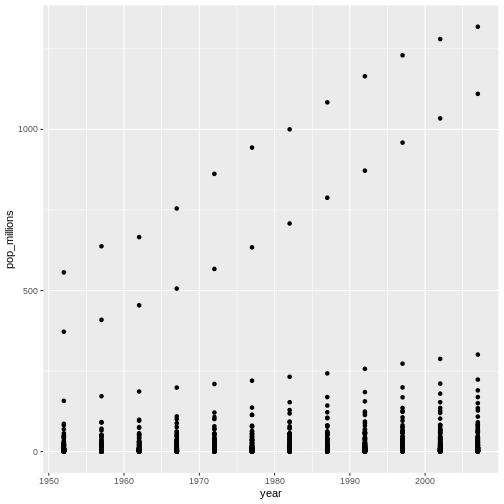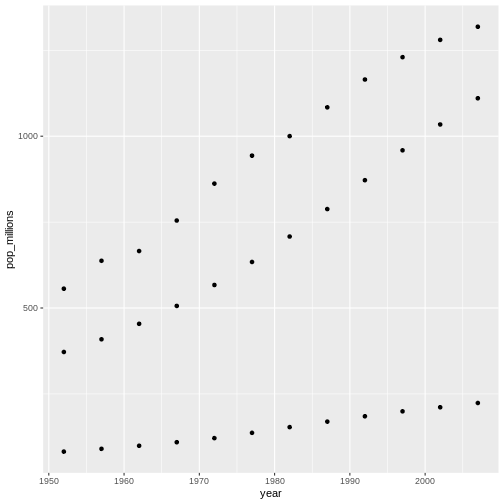Vectorization
Last updated on 2024-05-10 | Edit this page
Estimated time: 25 minutes
Overview
Questions
- How can I operate on all the elements of a vector at once?
Objectives
- To understand vectorized operations in R.
Most of R’s functions are vectorized, meaning that the function will operate on all elements of a vector without needing to loop through and act on each element one at a time. This makes writing code more concise, easy to read, and less error prone.
R
x <- 1:4
x * 2
OUTPUT
[1] 2 4 6 8The multiplication happened to each element of the vector.
We can also add two vectors together:
R
y <- 6:9
x + y
OUTPUT
[1] 7 9 11 13Each element of x was added to its corresponding element
of y:
Here is how we would add two vectors together using a for loop:
R
output_vector <- c()
for (i in 1:4) {
output_vector[i] <- x[i] + y[i]
}
output_vector
OUTPUT
[1] 7 9 11 13Compare this to the output using vectorised operations.
R
sum_xy <- x + y
sum_xy
OUTPUT
[1] 7 9 11 13Let’s try this on the pop column of the
gapminder dataset.
Make a new column in the gapminder data frame that
contains population in units of millions of people. Check the head or
tail of the data frame to make sure it worked.
R
gapminder$pop_millions <- gapminder$pop / 1e6
head(gapminder)
OUTPUT
country year pop continent lifeExp gdpPercap pop_millions
1 Afghanistan 1952 8425333 Asia 28.801 779.4453 8.425333
2 Afghanistan 1957 9240934 Asia 30.332 820.8530 9.240934
3 Afghanistan 1962 10267083 Asia 31.997 853.1007 10.267083
4 Afghanistan 1967 11537966 Asia 34.020 836.1971 11.537966
5 Afghanistan 1972 13079460 Asia 36.088 739.9811 13.079460
6 Afghanistan 1977 14880372 Asia 38.438 786.1134 14.880372Refresh your plotting skills by plotting population in millions against year.
R
ggplot(gapminder, aes(x = year, y = pop_millions)) +
geom_point()

R
countryset <- c("China","India","Indonesia")
ggplot(gapminder[gapminder$country %in% countryset,],
aes(x = year, y = pop_millions)) +
geom_point()

Comparison operators, logical operators, and many functions are also vectorized:
Comparison operators
R
x > 2
OUTPUT
[1] FALSE FALSE TRUE TRUELogical operators
R
a <- x > 3 # or, for clarity, a <- (x > 3)
a
OUTPUT
[1] FALSE FALSE FALSE TRUEMost functions also operate element-wise on vectors:
Functions
R
x <- 1:4
log(x)
OUTPUT
[1] 0.0000000 0.6931472 1.0986123 1.3862944Vectorized operations work element-wise on matrices:
R
m <- matrix(1:12, nrow=3, ncol=4)
m * -1
OUTPUT
[,1] [,2] [,3] [,4]
[1,] -1 -4 -7 -10
[2,] -2 -5 -8 -11
[3,] -3 -6 -9 -12Tip: element-wise vs. matrix multiplication
Very important: the operator * gives you element-wise
multiplication! To do matrix multiplication, we need to use the
%*% operator:
R
m %*% matrix(1, nrow=4, ncol=1)
OUTPUT
[,1]
[1,] 22
[2,] 26
[3,] 30R
matrix(1:4, nrow=1) %*% matrix(1:4, ncol=1)
OUTPUT
[,1]
[1,] 30For more on matrix algebra, see the Quick-R reference guide
Challenge 3
Given the following matrix:
R
m <- matrix(1:12, nrow=3, ncol=4)
m
OUTPUT
[,1] [,2] [,3] [,4]
[1,] 1 4 7 10
[2,] 2 5 8 11
[3,] 3 6 9 12Write down what you think will happen when you run:
m ^ -1m * c(1, 0, -1)m > c(0, 20)m * c(1, 0, -1, 2)
Did you get the output you expected? If not, ask a helper!
Given the following matrix:
R
m <- matrix(1:12, nrow=3, ncol=4)
m
OUTPUT
[,1] [,2] [,3] [,4]
[1,] 1 4 7 10
[2,] 2 5 8 11
[3,] 3 6 9 12Write down what you think will happen when you run:
m ^ -1
OUTPUT
[,1] [,2] [,3] [,4]
[1,] 1.0000000 0.2500000 0.1428571 0.10000000
[2,] 0.5000000 0.2000000 0.1250000 0.09090909
[3,] 0.3333333 0.1666667 0.1111111 0.08333333m * c(1, 0, -1)
OUTPUT
[,1] [,2] [,3] [,4]
[1,] 1 4 7 10
[2,] 0 0 0 0
[3,] -3 -6 -9 -12m > c(0, 20)
OUTPUT
[,1] [,2] [,3] [,4]
[1,] TRUE FALSE TRUE FALSE
[2,] FALSE TRUE FALSE TRUE
[3,] TRUE FALSE TRUE FALSEWe’re interested in looking at the sum of the following sequence of fractions:
R
x = 1/(1^2) + 1/(2^2) + 1/(3^2) + ... + 1/(n^2)
This would be tedious to type out, and impossible for high values of n. Can you use vectorisation to compute x, when n=100? How about when n=10,000?
R
sum(1/(1:100)^2)
OUTPUT
[1] 1.634984R
sum(1/(1:1e04)^2)
OUTPUT
[1] 1.644834R
n <- 10000
sum(1/(1:n)^2)
OUTPUT
[1] 1.644834We can also obtain the same results using a function:
R
inverse_sum_of_squares <- function(n) {
sum(1/(1:n)^2)
}
inverse_sum_of_squares(100)
OUTPUT
[1] 1.634984R
inverse_sum_of_squares(10000)
OUTPUT
[1] 1.644834R
n <- 10000
inverse_sum_of_squares(n)
OUTPUT
[1] 1.644834Tip: Operations on vectors of unequal length
Operations can also be performed on vectors of unequal length, through a process known as recycling. This process automatically repeats the smaller vector until it matches the length of the larger vector. R will provide a warning if the larger vector is not a multiple of the smaller vector.
R
x <- c(1, 2, 3)
y <- c(1, 2, 3, 4, 5, 6, 7)
x + y
WARNING
Warning in x + y: longer object length is not a multiple of shorter object
lengthOUTPUT
[1] 2 4 6 5 7 9 8Vector x was recycled to match the length of vector
y
